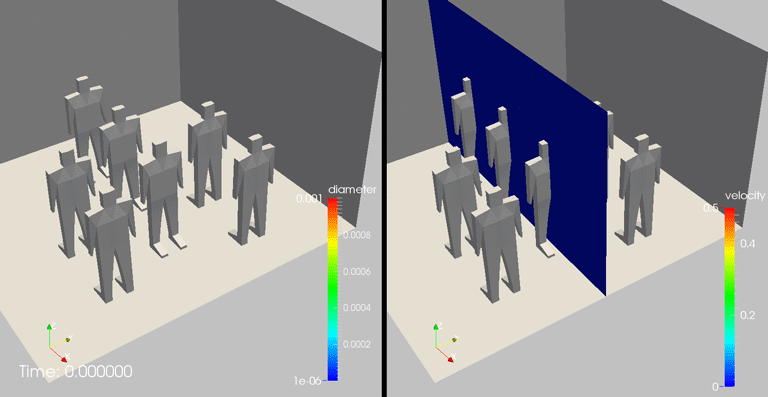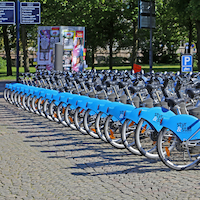news
Computational fluid dynamics simulation to predict the distribution of virus in the air after sneezing
CIMNE researchers are applying computational fluid dynamics models coupled with particle-based models to the simulation of the flow of virus in the air produced by a sneeze. This research is carried out in close cooperation with the group of Professor Rainald Lohner at George Mason University in the USA. Prof Lohner, who is also the PI in this research activity, is an affiliated scientist to CIMNE where he spends 2-3 months research periods every year since 1995.

Simulation of the flow of virus after the sneezing of a patient laying in a bed in a hospital room. Courtesy of Prof. Rainald Lohner
These virus flow simulations will be useful for predicting the distribution of virus in the air in closed and open environments, such as hospitals and supermarkets, among others. These predictions will be more relevant in highly populated spaces, such as airports or crowded hospitals.

Simulation of the flow of virus after the sneezing of a person surrounded by a group of persons. Courtesy of Prof. Rainald Lohner
The problem is particularly important to face the challenges that the Covid-19 crisis is posing to society. Many doctors, nurses, TSA personnel etc. can be infected needlessly because airflow is poorly understood or neglected. In order for the virus not to spread through medical facilities infecting people, the airflow needs to be managed so that no particles from rooms with Codiv-19 patients leave those rooms.
Furthermore, by being able to predicting how the airflow inside high-risk rooms is, the medical staff could position themselves so that the chances of infection are minimized. By using simulation technology these flows can be computed and the airflow can be optimized so that further infections are minimized.
Related items
-
04/03/2025By Clara Soler i Bañuelos In the coming years, public transport authorities will face unprec...
-
25/02/2025The International Centre for Numerical Methods in Engineering (CIMNE) has officially joined Secpho, ...
-
21/01/2025A novel study by researchers at CIMNE and the Port of Barcelona has developed an innovative framewor...
-
05/12/2024The FIBRE4YARDS project, coordinated by the International Centre for Numerical Methods in Engineerin...
-
26/11/2024Dealing with sustainable mobility challenges is no easy task: from technological barriers to physica...
-
13/11/2024CIMNE’s Innovation Unit in Transport, CENIT has released the Issue 3 of its magazine, Innovati...
-
23/10/2024CIMNE researchers last week presented two use cases for monitoring air quality in Barcelona and pred...
-
14/10/2024Photo: Myrabella / Wikimedia Commons / CC BY-SA 3.0 Around 3,000 maritime incidents occur every y...
-
07/10/2024Railway stations hold a unique position in the urban landscape: they not only act as complex nodes o...
-
02/10/2024Schools play a central role in urban spaces, often serving as a second home for children. But modern...
-
26/09/2024CIMNE’s innovation unit in transport, CENIT, is one of the more than 40 cross-cutting partners...
-
08/03/2024Researchers at CIMNE's Machine Learning in Civil Engineering Research Group and the Flumen Insti...
-
04/03/2024The International Centre for Numerical Methods in Engineering (CIMNE) has published a “one-sto...
-
20/02/2024Shipping container operators could move their long-haul Mediterranean hubs to Northern Africa to avoid the emissions tax, warn CIMNE experts
-
16/02/2024Dr. Pere-Andreu Ubach, from the Civil and Environmental Engineering research group at CIMNE, this we...
-
09/02/2024Researchers from the Center for Ecological Research and Forestry Applications (CREAF), the Internati...
-
30/01/2024Researchers at CIMNE have proposed novel material solutions to reduce the weight of electric car chassis components by 40%.
-
29/01/2024Researchers from the Machine Learning in Civil Engineering group at CIMNE have developed a new machi...
-
24/01/2024The Director of the International Centre for Numerical Methods in Engineering (CIMNE), Dr Javier Bon...
-
23/01/2024Doctor Juan Marcelo Gimenez, from the Structural Mechanics research group at CIMNE, has unveiled a&n...




















